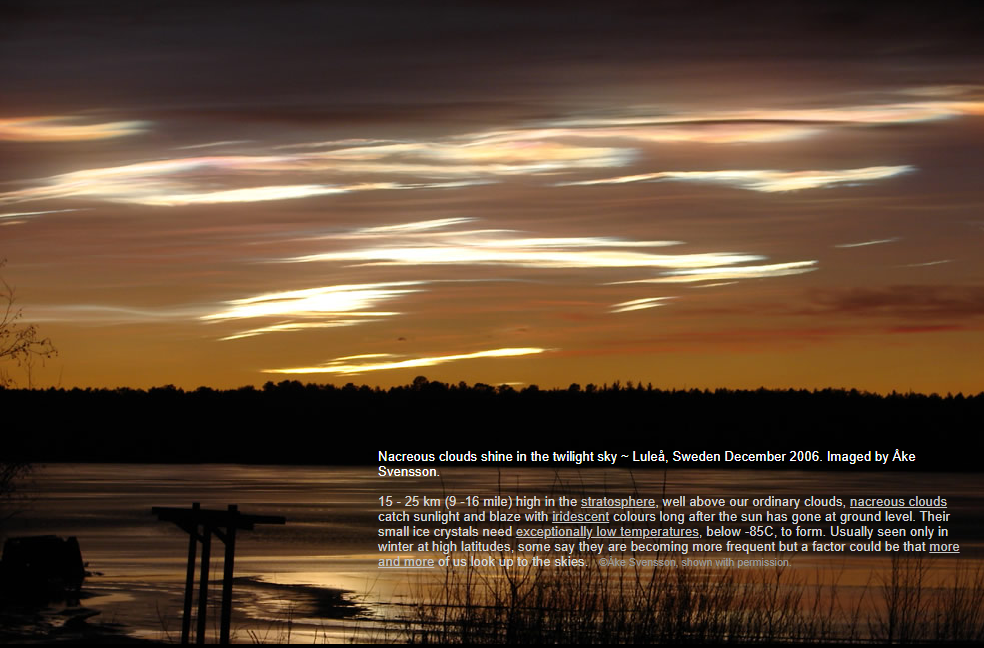Nacreous Clouds, Sweden
Nacreous Clouds: A Dazzling Phenomenon in the Skies of Sweden
Nacreous clouds, also known as polar stratospheric clouds, are a captivating atmospheric optics phenomenon that graces the skies of Sweden. These ethereal clouds, located approximately 15 to 25 kilometers (9 to 16 miles) high in the stratosphere, exist well above our ordinary clouds. What sets nacreous clouds apart is their ability to catch sunlight and radiate with iridescent colors long after the sun has set at ground level. In this article, we will delve deeper into the mesmerizing world of nacreous clouds, exploring their formation, unique characteristics, and the reasons behind their occurrence in Sweden.
The Formation of Nacreous Clouds
Nacreous clouds owe their stunning appearance to the presence of tiny ice crystals suspended in the stratosphere. Unlike ordinary clouds, which form at lower altitudes where temperatures are relatively mild, nacreous clouds require exceptionally low temperatures, plummeting below -85°C (-121°F), to take shape. These freezing conditions are only found in the frigid regions of the polar stratosphere during winter.
The Enchanting Colors of Nacreous Clouds
One of the most remarkable aspects of nacreous clouds is their iridescence. When sunlight interacts with the ice crystals within these clouds, it undergoes a process called diffraction. This phenomenon causes the light waves to bend and scatter, resulting in a mesmerizing display of vibrant colors. The intricate interplay of blues, pinks, purples, and oranges creates a breathtaking spectacle that captivates observers fortunate enough to witness it.
A Seasonal Rarity in High-Latitude Regions
Nacreous clouds are typically observed during winter months in high-latitude regions such as Sweden. The prevalence of these unique cloud formations can be attributed to the specific atmospheric conditions present during this time. The combination of low temperatures and stable air masses in the polar stratosphere creates an environment conducive to the formation of nacreous clouds.
The Increasing Frequency of Nacreous Cloud Sightings
While nacreous clouds have been documented for centuries, some reports suggest that their frequency may be increasing. However, it is essential to approach such claims with caution. One factor contributing to the perception of increased sightings could be the growing number of people who are now actively looking up at the sky and documenting atmospheric phenomena. The advent of smartphones and social media platforms has enabled individuals to share their experiences more readily, leading to a potential amplification in the perception of nacreous cloud occurrences.
Studying Nacreous Clouds for Scientific Insight
Nacreous clouds offer scientists a unique opportunity to gain valuable insights into the composition and dynamics of the stratosphere. By analyzing the properties of these clouds, researchers can better understand atmospheric processes and the impact of human activities on our environment. Additionally, studying nacreous clouds aids in monitoring the levels of ozone-depleting substances, as these clouds are closely linked to the depletion of ozone in the stratosphere.
The Beauty and Fragility of Nacreous Clouds
Nacreous clouds serve as a reminder of the delicate balance that exists within our atmosphere. Their formation is intricately tied to specific temperature and atmospheric conditions, making them a fragile phenomenon. As our planet undergoes changes due to climate variations, it is crucial to appreciate and protect these captivating displays of nature's artistry.
In conclusion, nacreous clouds in Sweden are a mesmerizing sight that showcases the beauty and complexity of our atmosphere. With their iridescent colors and unique formation requirements, these ethereal clouds continue to captivate observers. While their increasing frequency remains a subject of debate, their study offers valuable insights into our environment and the delicate interplay of atmospheric processes. As we marvel at the enchanting display of nacreous clouds, let us also recognize the importance of preserving our planet's atmospheric balance for future generations to witness these awe-inspiring phenomena.

Nacreous clouds shine in the twilight sky ~ Luleå, Sweden December 2006. Imaged by Åke Svensson.
15 - 25 km (9 -16 mile) high in the stratosphere, well above our ordinary clouds, nacreous clouds catch sunlight and blaze with iridescent colours long after the sun has gone at ground level. Their small ice crystals need exceptionally low temperatures, below -85C, to form. Usually seen only in winter at high latitudes, some say they are becoming more frequent but a factor could be that more and more of us look up to the skies. ©Åke Svensson, shown with permission.
Note: this article has been automatically converted from the old site and may not appear as intended. You can find the original article here.
Reference Atmospheric Optics
If you use any of the definitions, information, or data presented on Atmospheric Optics, please copy the link or reference below to properly credit us as the reference source. Thank you!
-
<a href="https://atoptics.co.uk/blog/nacreous-clouds-sweden/">Nacreous Clouds, Sweden</a>
-
"Nacreous Clouds, Sweden". Atmospheric Optics. Accessed on November 26, 2024. https://atoptics.co.uk/blog/nacreous-clouds-sweden/.
-
"Nacreous Clouds, Sweden". Atmospheric Optics, https://atoptics.co.uk/blog/nacreous-clouds-sweden/. Accessed 26 November, 2024
-
Nacreous Clouds, Sweden. Atmospheric Optics. Retrieved from https://atoptics.co.uk/blog/nacreous-clouds-sweden/.